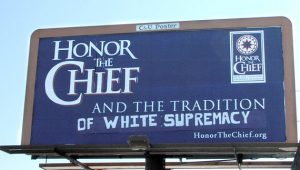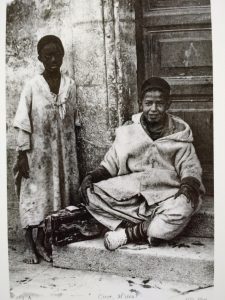 “Death and Resurrection of Chief Illiniwek (1926-2007),” Studies in Symbolic Interaction, vol. 34 (2010): 87-135. Updates and extends earlier 2001 essay. Updates it by discussing “retirement” of Chief Illiniwek by university in 2007. How supporters viewed retirement as that of an actual person, rather than that of a racist mascot. Supporters considered it a personal loss, called for “his” reinstatement. “Bring-back-the-Chief” actions continue to the present. Extends earlier analysis by detailing “noble savage” stereotype. Highlights different voices by featuring copious personal comments (articles and testimonials, letters to editor, contributions to online fora).
“Death and Resurrection of Chief Illiniwek (1926-2007),” Studies in Symbolic Interaction, vol. 34 (2010): 87-135. Updates and extends earlier 2001 essay. Updates it by discussing “retirement” of Chief Illiniwek by university in 2007. How supporters viewed retirement as that of an actual person, rather than that of a racist mascot. Supporters considered it a personal loss, called for “his” reinstatement. “Bring-back-the-Chief” actions continue to the present. Extends earlier analysis by detailing “noble savage” stereotype. Highlights different voices by featuring copious personal comments (articles and testimonials, letters to editor, contributions to online fora).
“Introduction: Orientalism from Postcolonial Theory to World History” (with Terry Burke), pp. 1-71 in Burke and Prochaska, eds., Genealogies of Orientalism: History, Theory, Politics (2008). Presents both the Anglocentric orientalism of Said and the South Asian subaltern historians, and the underrepresented Francocentric orientalist tradition of Sartre, Fanon, and the Algerian critics of colonial forms of knowledge. Provides a more complex and historicized genealogy of orientalism than previously available. This historicization of the critique of orientalist forms of knowledge requires relocating the critique of orientalism in the history of the human sciences, especially after the linguistic and cultural turns over the last 30 years; inserting the object of study, and its author, into its political and intellectual fields; and reinscribing the colonial moment in the context of world history. To accomplish this, argues that a historical turn must be made, and the ways in which modernity itself is theorized and historicized must be rethought.
 “At Home in Illinois: Presence of Chief Illiniwek, Absence of Native Americans,” pp. 157-185 in Charles Springwood and Richard King, eds., Team Spirits (Lincoln: University of Nebraska Press, 2001). Analyzes University of Illinois’s racist sports mascot, “Chief Illiniwek,” in terms of another othering discourse, Americanism. Applies postcolonial theory, specifically invented traditions, imperialist nostalgia, imagined community, and playing Indian to mascot controversy. Between an “honored symbol” and a racist mascot, proponents and opponents largely talked past one another. A “positive” stereotype, yes, but a stereotype nonetheless. Engages history, memory, and trauma by drawing on Freud’s “return of the repressed” to describe how continual return of Chief Illiniwek at halftime restages but leaves unresolved original historical trauma of white over Indian. Identity of local community largely revolves around Chief Illiniwek, yet it is based on a person that never existed, a non-person, a sign signifying nothing.
“At Home in Illinois: Presence of Chief Illiniwek, Absence of Native Americans,” pp. 157-185 in Charles Springwood and Richard King, eds., Team Spirits (Lincoln: University of Nebraska Press, 2001). Analyzes University of Illinois’s racist sports mascot, “Chief Illiniwek,” in terms of another othering discourse, Americanism. Applies postcolonial theory, specifically invented traditions, imperialist nostalgia, imagined community, and playing Indian to mascot controversy. Between an “honored symbol” and a racist mascot, proponents and opponents largely talked past one another. A “positive” stereotype, yes, but a stereotype nonetheless. Engages history, memory, and trauma by drawing on Freud’s “return of the repressed” to describe how continual return of Chief Illiniwek at halftime restages but leaves unresolved original historical trauma of white over Indian. Identity of local community largely revolves around Chief Illiniwek, yet it is based on a person that never existed, a non-person, a sign signifying nothing.
 “History as Literature, Literature as History: Cagayous of Algiers,” American Historical Review, vol. 101 (1996): 670-711. Historicizes popular literary figure Cagayous, one of primary European representations of colonial Algeria. A Mediterranean-wide trickster character, a picaro, Cagayous is a petit blanc, poor white, that employs scatological humor. Related to Karagöz, the chief Ottoman puppet theater marionette, and the trickster known as J’ha in Morocco and Djoha in Algeria. Appeared as feuilletons, newspaper serials, 1894-1920. Significantly, tales written in pataouète, a patois created at same time in Algiers, where Cagayous firmly rooted. Featured both fictional characters and contemporary people. Wildly popular, Cagayous embraced as if a real person. Coincides with emergence of Algerian colonial novel, a major theme of which was that pieds noirs, European settlers, formed a distinctive settler colonial society 1890-1914. Essay resists both aestheticizing Cagayous as picaresque literary figure, and deshistoricizing him by occluding Algerian context. Argues instead that Cagayous both reflects colonial Algeria, and actively contributed to formation of settler colonial Algeria, a sexist and racist society that included French and non-French settlers, and excluded Algerians and Jews.
“History as Literature, Literature as History: Cagayous of Algiers,” American Historical Review, vol. 101 (1996): 670-711. Historicizes popular literary figure Cagayous, one of primary European representations of colonial Algeria. A Mediterranean-wide trickster character, a picaro, Cagayous is a petit blanc, poor white, that employs scatological humor. Related to Karagöz, the chief Ottoman puppet theater marionette, and the trickster known as J’ha in Morocco and Djoha in Algeria. Appeared as feuilletons, newspaper serials, 1894-1920. Significantly, tales written in pataouète, a patois created at same time in Algiers, where Cagayous firmly rooted. Featured both fictional characters and contemporary people. Wildly popular, Cagayous embraced as if a real person. Coincides with emergence of Algerian colonial novel, a major theme of which was that pieds noirs, European settlers, formed a distinctive settler colonial society 1890-1914. Essay resists both aestheticizing Cagayous as picaresque literary figure, and deshistoricizing him by occluding Algerian context. Argues instead that Cagayous both reflects colonial Algeria, and actively contributed to formation of settler colonial Algeria, a sexist and racist society that included French and non-French settlers, and excluded Algerians and Jews.
“Tales of the City: Between Algérie française and Algerie algérienne,” in Daniel Segal, ed., Crossing Cultures: Essays in the Displacement of “Western Civilization” (Tucson: University of Arizona Press, 1992), 182-225. A shorter version appeared in “Making Algeria French and Unmaking French Algeria,” Journal of Historical Sociology, vol. 3 (1990), pp. 305-328, and reprinted in Derek Sayer and Yoke-Sum Wong, eds., The Best of The Journal of Historical Sociology (Wiley-Blackwell, 2007). Exemplifies view that colonialism is a relationship by presenting narrative of French colonizers “making Algeria French,” followed by that of colonized Algerians “unmaking French Algeria” in Annaba and beyond, 1830-1962. Ranges over economy, politics, language and culture. Highlights individuals (Albert Camus, Jules Ferry, Abd al-Hamid Ben Badis, Messali Hadj). Interrupts linear narrative with numerous parenthetical inserts, and select personal vignettes.
 “‘Disappearing’ Iraqis,” Swords and Ploughshares (University of Illinois Program in Arms Control, Disarmament, and International Security bulletin), vol. 5 (1991), 13-16. A much shorter version appeared in Public Culture, vol. 4 (1992), pp. 89-92. Discusses anti-Arab stereotypes during Persian Gulf War (1990-1991) as an othering discourse rooted especially in orientalism (“camel jockeys,” “towel heads”). Demonization of Saddam Hussein (“Beast of Baghdad”). Staged as an event, the Gulf War was presented primarily as video, as a movie. The Iraqis were first “disappeared” in our thoughts, then in our deeds. Based on an antiwar presentation.
“‘Disappearing’ Iraqis,” Swords and Ploughshares (University of Illinois Program in Arms Control, Disarmament, and International Security bulletin), vol. 5 (1991), 13-16. A much shorter version appeared in Public Culture, vol. 4 (1992), pp. 89-92. Discusses anti-Arab stereotypes during Persian Gulf War (1990-1991) as an othering discourse rooted especially in orientalism (“camel jockeys,” “towel heads”). Demonization of Saddam Hussein (“Beast of Baghdad”). Staged as an event, the Gulf War was presented primarily as video, as a movie. The Iraqis were first “disappeared” in our thoughts, then in our deeds. Based on an antiwar presentation.
 “Approaches to the Economy of Colonial Annaba, 1870-1920,” Africa, vol. 60 (1990), pp. 497-523. Divided into sixteen sections organized like architectonic facets rather than a linear narrative. Ranges from mode of production and world systems analysis, economic dualism, informal economy, and “development of underdevelopment” approaches, to postcard representations of work, and personal vignettes.
“Approaches to the Economy of Colonial Annaba, 1870-1920,” Africa, vol. 60 (1990), pp. 497-523. Divided into sixteen sections organized like architectonic facets rather than a linear narrative. Ranges from mode of production and world systems analysis, economic dualism, informal economy, and “development of underdevelopment” approaches, to postcard representations of work, and personal vignettes.
“Fire on the Mountain: Resisting Colonialism in Algeria,” pp. 229-52 in Donald Crummey, ed., Banditry, Rebellion and Social Protest in Africa (Portsmouth, NH: Heinemann, 1986). European and French social history, especially social banditry, applied to colonial Algerian forest fires. Details precolonial political economy of Berber peasant agriculturalists; large-scale colonial French cork oak forest concessions given to wealthy individuals, notables, and cronies; Algerian resistance including arson; settler colonial invention of myth of Algerian banditry; and concessionaires “making out like bandits” thanks to government indemnification for their fire losses. Bracketed at beginning and end with a conversation with my Algerian landlord discussing 1970s forest fires.
